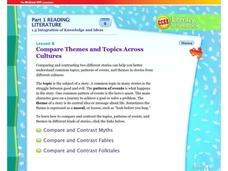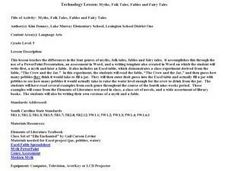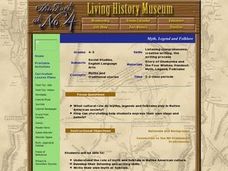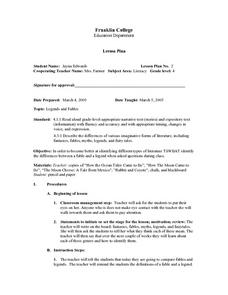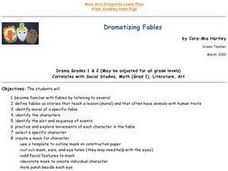Curated OER
Introduction to Myths, Fables, and Legends
Middle schoolers identify elements of myths, fables, and legends as they read an example of each. After reading an example of each type of story, they list elements from each. They compare and contrast these features by...
Curated OER
Mayan Myths/Folktales
Middle schoolers work on summarizing a story, and they determine if it is a legend, a myth, or a fable. Working in groups to read and summarize stories, they then list evidence whether the tale is a myth, fable, or...
Curated OER
Those Fabulous Fables
A video leads off this activity on fables, introducing the class to this important form of traditional storytelling. The group defines fable and hears an explanation of the origin of this type of folk tale. They summarize the story they...
Curated OER
Aesop's Fables
Regale your class with renditions of Aesop's fables from the engaging, and beautifully illustrated book by Jerry Pinkney. Guide discussion to practice prediction, compare and contrast various stories, explore the connections between the...
McGraw Hill
Compare Themes and Topics Across Cultures
Compare and contrast folktales, myths, and fables in an interactive eBook. The interactive is broken up into three topics: myths, fables, and folktales. Each section includes a reading passage and a guided lesson on the theme, topic, and...
Curated OER
Myths, Folk Tales, Fables and Fairy Tales
Fifth graders study the differences in the four genres of myths, folk tales, fables and fairy tales. They use a PowerPoint Presentation, an assessment in Word, and a writing template also created in Word on which they write first, a...
Curated OER
Myths, Legends, and Fables
In this social studies worksheet, students find the words that are related to the legends of mythology and the answers are found at the bottom of the page.
Curated OER
Myth, Legend and Folklore
Students examine the role of myths and folklore in the Native American culture. They listen to examples of oral history and write their own. They share their story with the class.
Curated OER
Fantasy, Fables, Myths, Legends & Fairy Tales
Students identify the differences between fantasies, fables, myths, legends and fairy tales. In groups, they create their own versions of the different genres. They practice identifying the examples, as well.
Curated OER
Legends and Fables
Fourth graders identify and discuss the differences between legends and fables. They define fable and legend, then as a class take turns reading our books. Students select two of the stories, and complete a Venn diagram, comparing one...
Curated OER
Fantasies and Myths
Fourth graders examine different types of literature, specifically myths and fantasy. They listen to "The Giving Tree", identify in which genre of literature it belongs, and view several myths on a website. At end of lesson, 4th...
Curated OER
Greek Mythology -- Part II
Students use the internet to gather information about Greek Mythology. They discover the role of the snake and shamrock and the history of St. Patrick's Day. They compare and contrast their culture to another.
Curated OER
Elements of the Oral Tradition
Various genres of oral tradition are outlined and defined in these slides. Give your class examples of folk tales, fairy tales, parables, fables, legends, and myths before reading an example of one of these stories. This overview acts as...
Curated OER
Lots of Lessons from Aesop
Aesop’s Fables offer young learners an opportunity to study figurative language. After reviewing theme, simile, alliteration, and metaphor, model for your pupils how to identify examples of these devices in the fable. Class members then...
Pearson
Catching the Sun: Tales from Asia
Explore the folklore of Asia and the South Pacific with this language arts lesson series. Complementing a reading of Catching the Sun: Tales from Asia by Jan M. Mike, this resource supports learners with understanding cause and...
Curated OER
Fairy Tales and Folklore Tell about....
Every elementary age child learns about the different genres of literature, this PowerPoint will give them a clear idea of what to look for when identifying Folklore and Fairy Tales. Each slide describe the characteristics of Folklore,...
Curated OER
Dramatizing Fables
Students familiarize themselves with fables by listening to several of them. They define fables. They identify the moral of a specific fable. They identify characters, plot and sequence of events. They create a mask of a character in a...
Curated OER
Fantasies and Myths
Fourth graders listen to the book, THE GIVING TREE and discuss what genre category they believe the story fits into and why. They read of of the myths on the website on the computers and then come back together as a group and discuss...
Curated OER
Writing Myths II
Students complete a final draft of a myth. In this writing myths lesson, students complete their rough drafts, have a one-on-one meeting with the teacher to enhance ideas, and peer edit. Students use the comments and...
Curated OER
"Theseus and the Minotaur"
Young scholars analyze the features of myths and legends. They read the myths "Theseus and the Minotaur" and "Orpheus and Eurydice," identify the myth story elements, evaluate each story for the overall theme, describe the characters,...
Curated OER
Myths and Folk Tales
Seventh graders perform research in order to appreciate stories taken from the genre of myths and fables. The examples of the stories create a context for students to create their own myths.
Curated OER
Fable of the Fainting Goat
Second graders explore animal life by reading children stories in class. In this goat fable lesson, 2nd graders read several books which describe the different myths and folklore about goats. Students identify the needs of living animals...
Curated OER
Storytelling
Students explore the origins of folktales, fairytales, myths, legends, fables, and folktales in the ten lessons of this unit. A storytelling festival is held to feature the results of the variety of activities presented in the unit.
Curated OER
Folklore and Culture
Sixth graders explore the four kinds of folklore in this seven lesson unit. Through reading a variety of legends, muths, fables, and folklores the concepts pf the lessons are synthesized byStudents.
Other popular searches
- Fables and Myths
- Greek Myths and Fables
- Folk Tales Myths Fables
- Legends Myths Fables
- Myths Fables Trust
- Fables, Myths and Legends
- African Fables and Myths
- Myths Fables Native American
- Myths Fables Mayan Aztec
- Myths Fables Mayan
- Africian Fables and Myths
- Fables Myths and Legends






